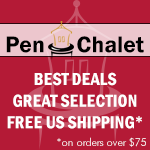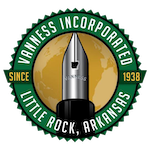There are few pens that match the iconic design of the Lamy 2000. That's a bold statement, but this is a pen that's included in the Museum of Modern Art.
It's not uncommon to hear negative thoughts on the 2000 because of it's finicky nib. It seems Lamy have a quality control issue with this model, because it happens far too often. Yes, I'm starting this off with the negative aspect first because I want to get it out of the way.
Full disclaimer: the Lamy 2000 that I bought had a problematic nib out of the box. It wrote, but it wasn't smooth and it wasn't enjoyable. It caused anxiety and frustration more often than good feelings. With a pen that looks so awesome (and cost this much), you expect it to write with 100% consistency.
I bought my 2000 before the 2014 Atlanta Pen Show. I did this on purpose so that I could bring it along in case it had a bum nib. I'm glad I made that choice, because it did have a bum nib, and I was able to have Mike Masuyama fix it for me. If I didn't end up going to the show, I would've sent it off to a nib meister shortly after receiving it.
I love my Lamy 2000, and I think it's a great pen. But, if you buy one, it might be wise to set aside a little bit of money for nib work – just in case. That's my advice, but I really hope that the pen you buy is perfect right out of the box.
Now, on to the good stuff about this pen.
Looks
Not to be superficial, but I kind of think other pens are jealous of how hot this pen is. I know that's just personal preference, but I'm smitten.
The Lamy 2000 is unique. There isn't another pen like it in design. It's sleek, modern, and welcoming at the same time. It looks like a pen meant to write, but classy at the same time. It works with casual and dress clothes splendidly. It always gets comments out in the wild.
One of my favorite aspects of the pen is the grip and nib section. The nib is hooded, and looks very small since most of it is hidden beneath the metal grip. Now, I'm no expert in metals, but I think the grip is stainless steel. Whatever it is, it feels fantastic to hold.
The body is made of Makrolon, a form of fiberglass. It looks unique, but it also feels unique. It's a subtle difference, but I always notice it. After you write for a while, the body warms up as it rests on your hand. When writing, my fingers rest on the stainless steel grip and the body rests on my hand. I've written with this pen over numerous long writing sessions, and it never got uncomfortable. It's a great material, and well-balanced in the hand.
I normally write with this pen unposted, but it also feels well-balanced when posted.
The pen is a piston filler, and the piston section is so flush with the rest of the pen body, that it's often easy to miss. I love this aspect of the design. It makes the pen look like a solid, single piece.
Another fascinating design feature is the ink window. Toward the grip section of the barrel, some of the Makrolon is thin enough to let light through so you can see (roughly) how much ink is left. This is nothing similar to a demonstrator body – it's in no way completely transparent, but it does allow you to keep an eye on your ink level. It's a great feature.
Writing
Ah, the writing. At the start, the nib was inconsistent with ink flow, and it tended to stick to the page a bit. It's hard to describe, but it was dry and seems to be held to the page with some sort of really mild adhesive. Despite cleaning the pen numerous times, this didn't go away. I took it to Mike Masuyama in April, and he smoothed it out and increased the flow. Now it writes like a dream.
This is my first gold Lamy nib, and it's not dramatically different from the steel nibs, but I do notice it every now and then. There's more give in the gold nib compared to a steel nib.
Even after being adjusted, the nib still requires a fairly strict angle of attack on the page. I've grown used to this unique aspect of the pen, and after a few sentences, I don't even have to think about it.
As I said earlier, I love writing with this pen, and that's really all that matters. I'm really happy with the work Mike did on the nib, and I hope that everyone who owns or purchases one of these little beauties has a good nib to begin with or a good nib meister that can help.
Overall, I recommend the Lamy 2000. I've heard that some vendors will check the nib before they ship the pen to you – if you ask them to. Sure, you might get a bum nib, and I don't think that's right considering the price tag. That considered, a well-writing Lamy 2000 is a glorious thing. I think it's worth the risk.
I personally bought a fine nib model, but they have extra fine, medium, and bold as well. I'm tempted to have Mike put a cursive italic on it next time, but we'll see.
(You can find more from Jeff online at Draft Evolution, Twitter, and App.net.)


















